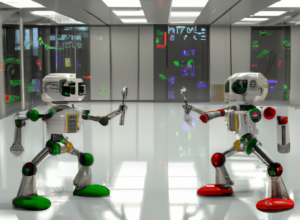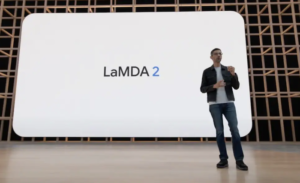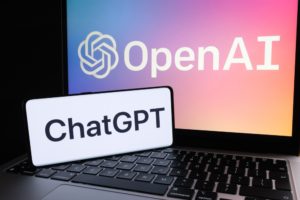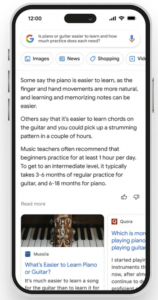
Chatbot Search Wars Intensify with Google’s Bard and Microsoft’s Unveiling of AI-powered Bing

(Image created by the author using OpenAI's DALL-E 2)
Google has officially thrown its hat into the chatbot ring with the unveiling of Bard, its answer to OpenAI’s ChatGPT.
“Bard seeks to combine the breadth of the world’s knowledge with the power, intelligence, and creativity of our large language models,” wrote Google CEO Sundar Pichai in a blog post. “It draws on information from the web to provide fresh, high-quality responses. Bard can be an outlet for creativity, and a launchpad for curiosity, helping you to explain new discoveries from NASA’s James Webb Space Telescope to a 9-year-old, or learn more about the best strikers in football right now, and then get drills to build your skills.”
ChatGPT, launched in November, has become a household name and gained millions of users since OpenAI made it available to the public. Microsoft recently invested $10 billion into a third-round partnership with OpenAI, and Google is said to have declared a “code red” since Microsoft announced intentions to incorporate ChatGPT within its Google Search rival, Bing. One might wonder if Bard’s pithy name—four-lettered, singularly syllabic, and beginning with a B—is also a response to the threat of an AI-powered Bing.
That threat will soon become a reality. Microsoft held a surprise event today at its Redmond HQ where it announced the coming availability of an AI-powered Bing. The new Bing experience is a culmination of several technical breakthroughs, the company said in a blog post, including a new, next-generation OpenAI LLM that is more powerful, fast, and accurate than ChatGPT and is customized specifically for search. In addition to a new user experience and the application of the AI model to Bing’s core search engine, Microsoft also claims to have developed a proprietary method of monitoring the training and development of OpenAI’s model, which it says gives more relevant, timely, and targeted results.
Pichai announced his company will initially roll out Bard with a lightweight model version of its LaMDA conversational AI model. LaMDA stands for Language Models for Dialogue Applications and debuted in May 2021. LaMDA was built on Google’s own open source Transformer neural network and was trained on 137 billion parameters with dialogue from a dataset of 1.56 trillion words from public web data and documents. A second finely tuned version launched a year later in May 2022, and the dialogue it produces sounds so compellingly human that a former senior Google engineer claimed LaMDA was sentient.
Pichai says Bard’s smaller version of LaMDA uses substantially less computing power, which will enable a larger user base and more feedback. It is unclear who is currently among the first to use Bard, as Pichai mentions it is now available to “trusted testers” ahead of a promised wider availability to the public, teased with the ambiguous timeline of “in the coming weeks.”
A possible reason for Google’s vague timetable is the need for more testing and tuning. Google mentioned its concerns about possible issues when it released LaMDA 2 last year, with Pichai acknowledging that the technology had a long way to go and could still generate inaccurate, inappropriate, or offensive responses. Pichai now says the company will combine external feedback with its own internal testing to ensure Bard’s responses meet Google’s standards for quality, safety, and groundedness. Groundedness is defined by Google as “the percentage of responses with claims about the external world that can be supported by authoritative external sources,” and is a metric used to score LaMDA’s responses in the fine-tuning phase of training.
Due to the aggregate nature of the internet-sourced datasets used to train AI chatbots, some of their responses would definitely not be supported by authoritative external sources. Chatbots are prone to hallucinations, or generated content that is nonsensical or unfaithful to the model’s training data. One estimate shows the hallucination rate for ChatGPT is 15% to 20%, which is actually an improvement over its predecessor GPT 3.5’s 30% hallucination rate. The hallucination rate for LaMDA is not publicly available, but its creators added the groundedness training metric with the goal of increasing the model’s accuracy in order to lessen its flights of fancy. It will be interesting to see how well this works for Bard and whether this search engine war becomes a Shakespearean history, comedy, or even a tragedy.
So, when can we expect a Bard-powered Google Search experience? Pichai hints at future capabilities, especially for generating answers to complex questions: “Soon, you’ll see AI-powered features in Search that distill complex information and multiple perspectives into easy-to-digest formats, so you can quickly understand the big picture and learn more from the web: whether that’s seeking out additional perspectives, like blogs from people who play both piano and guitar, or going deeper on a related topic, like steps to get started as a beginner. These new AI features will begin rolling out on Google Search soon,” he wrote.
It appears Google is firing back at Microsoft’s surprise event and will present its latest work in AI tomorrow, Feb. 8, during a live event to be streamed on YouTube at 8:30 a.m. ET. It is anyone’s guess how much information will be given about Bard, but the company says the event will reveal “the power of AI to reimagine how people search for, explore and interact with information, making it more natural and intuitive than ever before to find what you need.”
Related Items:
OpenAI Outsourced Data Labeling to Kenyan Workers Earning Less than $2 Per Hour: TIME Report
Hallucinations, Plagiarism, and ChatGPT
Google Debuts LaMDA 2 Conversational AI System and AI Test Kitchen

































